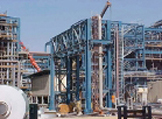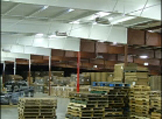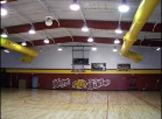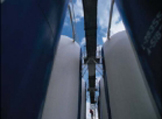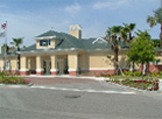Painting Terms

Learn Painting Terms - S
Browse Our Painting Terms
Sag - (See Run)
Sagging - Paint running down immediately after application. Usually caused by - inadequate surface preparation; over thinned paint; applying paint too thickly; spraying with gun too close to surface; painting when too cold or humidity is too high.
Sal Soda - Crystallized sodium carbonate. It is used for making cleaning solutions to remove grease and grime from old painted surfaces.
Sand Blasting - An abrasive blasting process in which sand is blown at high pressure against a surface.
Sand Down - To use sandpaper or other abrasive to smooth a new surface or to remove the gloss of an old finish.
Sand Dry Surface - A surface on which sand will not stick.
Sand Finish - A sand like finish applied to an interior or exterior wall.
Sanding Sealer - A first coat of paint which seals or fills wood but does not hide the grain.
Sanding Surfaces - A heavily pigmented finishing material used for building the surface to a smooth condition. It is sanded after drying.
Sandpaper - A sheet of abrasive coated paper that is used for smoothing rough surfaces.
Sap Streak - Streaks showing through a finished wood surface which contains sapwood.
Saponification - A chemical decomposition of a paint's binder by alkali and moisture from a substrate (e.g., new concrete or fresh plaster). Saponified paint may deteriorate, lose its adhesion, and become discolored.
Sash - The framework which holds the glass in a window or door.
Sash Bar - A strip which separates the panes of glass in a window sash. Also called muntin.
Sash Brush - A angled brush made for detail painting of windows and narrow trim pieces
Satin Finish - See Semi-Gloss
Scaffold Height - The height of the wall which requires another raising of the scaffold to continue the building process.
Scaffolding - Any temporary elevated platform and its supporting structure used for supporting workers and materials.
Scale - (1) A measuring device used in proportional drafting. (2) Rust which has formed into thin layers.
Scrubbability - The ability of a paint film to withstand scrubbing and cleaning with water, soap, and other household cleaning agents.
Scrubbing Failure - excessive wearing away of paint film from repeated scrubbings. Usually caused by abrasive cleanser; using flat sheen paint in gloss sheen area; scrubbing before paint has properly cured.
Scuff Sand - A light surface sanding.
Scuppers - Water overflow outlets in parapet, deck or courtyard walls.
Sealant - Often used as a synonym for "caulk." The word "sealant" usually means a compound that has greater performance than a caulk, i.e., it can accommodate movement in a joint or crack.
Sealer - Liquid coating, usually clear, used to close or fill the pores of wood and other building materials before applying the finish coats.
Secondary Colors - Colors formed by mixing together two primary colors (i.e. orange, green, and purple).
Section Drawing - An illustration of an object cut lengthwise to show its structure and components.
Seedy - A painted surface with small grains of dirt and old paint particles left by the dirty heel of a brush. Also called sandy.
Self-Cleaning - An exterior paint designed to chalk quickly to maintain a clean appearance.
Semi Gloss Finish - A finish with a low luster.
Semi Transparent - A degree of hiding greater than transparent but less than opaque.
Semi Transparent Stain - A stain that alters the natural color of the wood while allowing the grain and texture to show through.
Set - A condition of paint or varnish that has stopped flowing but is not in the final hardening stage.
Settling - The sinking of paint pigment and other particles as they separate from the paint vehicle and accumulate on the bottom of the paint can.
Setup - (1) The hardened state of a paint coating film. (2) Ready to begin preparation and painting operations.
Shade - The degree of darkness or gradation of a color. Shadowing Subsurface coatings showing through the finish coat. Also called show-through.
Shake Painter - A rectangular-shaped flat pad with an attached handle that is used to paint shingles, shakes and other special surfaces and areas.
Sheen - The gloss seen at a glancing angle on an otherwise flat paint finish.
Sheen Uniformity - The even distribution of luster over the entire surface of an applied finish.
Shelf Life - The maximum time a material may be stored and remain usable.
Shellac - A thin type of varnish consisting of lac dissolved in denatured alcohol used as a wood coating and sealer.
Shiner - A spot which has more gloss than the rest of the same surface.
Shingle Stain - A form of oil paint very thin in consistency, intended for coloring wood surfaces, such as shingles, without forming a coating of significant thickness or gloss.
Shop Primed - Prime coated in a manufacturing facility
Short Paint - Paint with poor qualities.
Shorts - Wallcovering term for those areas which are not a full drop or a header. Shorts occur at cut-up areas and under windows.
Silane - A silicone-like substance that is added to caulks and sealants to improve their adhesion to glass and aluminum under wet conditions.
Sidewalk Superintendent - This is the neighbor that always comes around checking on your work, and he tells you how you could do it better. Typically this person is retired, and has no knowledge of painting whatsoever.
Silica - Silicon dioxide used as an extender, derived from ground quartz or sand.
Silicate - Any one of a large family of substances chiefly used with titanium dioxide, the primary pigment, as an extender pigment. When used in moderation, these silicates (magnesium silicate, aluminum silicate, etc.) are valuable in helping control gloss, aid brushability, and increase hold-out properties and overall exterior durability.
Silicone - When combined with paint it is highly resistant to dirt, fungus, high temperatures, water and graffiti.
Siliconized Acrylic Sealant - Similar to an acrylic sealant, except it has a small amount of silane (hence, its name) added to it, which enhances adhesion to glass and aluminum under wet conditions.
Single Color Scheme - Utilization of different values of a single color in a decorating scheme. Also called monochromatic.
Size - A liquid composition that prevents excessive absorption of paint or wallpaper adhesive into plaster, wallboard, or a similar porous interior surface.
Sizing - A seal coat, usually clear, used for filling porous surfaces in preparation for the application of finish coats of paint or wallcovering.
Skin - (1) The outer layer of a dried paint film. (2) Roller cover.
Skipper - A spot on a painted surface which has been skipped. (Also see, Cat eye and Holiday)
Skippy - Paint which causes the brush to skip leaving uncoated spots and other areas which dry too quickly.
Skips - Areas left unpainted by mistake.
Slag Abrasive - A blast cleaning abrasive made from slag produced by metal-smelting operations or by coal-fired boilers and power plants. Most slag's are processed by quenching in water, crushing when necessary, washing, and screening to produce an acceptable abrasive. Slag abrasive manufactured by an air-cooling process has different mineral structure. The quality and durability of the abrasive depends upon the processing and can vary widely from batch to batch and from source to source.
Slip Under The Brush - A description of coating materials which are easy to apply.
Slow Dry - A coating which takes more than 24 hours to dry before the next operation.
Small Roller Frame - They range in sizes from 3" to 6". They are used in hard-to-reach surfaces like painting the area behind toilet tanks, painting around closet shelves, painting small rooms, closets etc.
Softwood - Lumber cut from needle-bearing trees of the conifer type without reference to the actual hardness of the wood.
Solids - The film of paint, varnish or lacquer film which dries on the surface after the vehicle has evaporated.
Soluble - The ability of a material to be dissolved in a liquid. For example, sugar is soluble in water.
Solvent - A liquid which is capable of dissolving another substance Solvents are used to increase the flow of various paints and to clean paint from application tools.
Source Reduction - Steps taken to reduce waste generation and toxicity at the source through more effective utilization of raw materials and reformulation.
Spackling - A filler, often used for filling cracks and holes, that prepares surfaces before painting.
Spackling Compound - A dry powder that mixes with water to form a paste used for patching and filling holes and cracks in plaster, gypsum wallboard and sometimes wood.
Spackling Paste - A pliable clay or putty like material used for patching and filling holes and cracks in plaster, gypsum wallboard, and sometimes wood.
Spalling - Surface cracking, chipping or particles flaking from a surface.
Spar Varnish - Varnish that is primarily used on exterior surface! It forms a hard, durable, weather-resistant protective finish.
Spattering - Droplets of paint that spin or mist off the roller as paint is being applied.
Specifications - Written instructions for a project that describe the nature of the materials, finishes and quality of workmanship.
Specular Gloss - Mirror-like finish (usually 60 degrees on a 60-degree meter).
Spindle - (1) A small axle, as the spindle of a vane on which doorknobs are fixed. (2) A short turned member, as that on a baluster.
Spirit Stain - A dye used for darkening wood which is dissolved in alcohol and shellac or other resin used as a binder.
Spirit Varnish - A varnish produced by dissolving a resin or gum in alcohol.
Split Coat - A mixture of half enamel and half undercoater which is applied between the undercoat and the enamel coat. It is an upgrade from the usual undercoat and enamel process.
Split Face - A rough face formed by guillotining cast or natural stone units (masonry block).
Splitting - A later stage of alligatoring that occurs when paints or varnishes are applied over subsurface coatings which were not completely dry or hardened.
Sponge Painting (Sponging) - An interior painting technique in which sponges are used to apply or partially remove a coat of paint.
Spot Prime - The process of applying a primer to areas where paint has been removed or stripped to the original surface.
Spray - A fine jet of liquid particles or mist from an atomizer, aerosol or spray gun.
Spray Can - A can in which gas under pressure is used to disperse the contents in the form of a spray.
Spray Coating - Coating which involves spraying a liquid coating substance onto an object or material.
Spray Gun - A device that shoots out a spray of liquid by air pressure from a compressor.
Spray Painting - Applying paint, lacquer or other coating with a spray unit.
Spray Texture - Mechanically, applied material that produces various decorative finishes, common in the drywall trade.
Spraying - A method of application in which the coating material is broken up into a fine mist that is directed onto the surface to be coated.
Spread Rate - The square feet of surface area covered by one gallon of mixed paint.
Stain - Color in a dissolving vehicle. When spread on an absorbent surface, it penetrates and gives its color to the wood or other material.
Stain Bleed Through - When tannin found in certain types of wood (such as cedar or redwood) migrates through the coating, causing discoloration. Also, discoloration from a contaminant on the substrate.
Stain Grade - A description of high-quality material, usually wood that will have a pleasing appearance when stained.
Stain Resistance - The ability of a coating to resist soiling.
Stand Oil - Oil which is thickened by heat.
Standard Roller Frame - This is usually the 9 in. frame and the most popular. It is ideal for painting average sized rooms and ceilings, like 10-foot wide walls, and 8-foot high ceilings, and a closet.
Steeple - A tower and spire, usually on a church.
Steeplejack - A worker who repairs and paints steeples or other tall structures.
Stenciling - A method of applying a design by brushing or sponging paint through a cutout overlay placed on the surface
Stipple - Dabbing a coat of paint with a stippler brush to remove regular brush marks immediately after coating, to break up the color coat with spots of a different color, or to break up its texture with a bristle or rubber stippler.
Stippler - A paint brush with many tufts of soft bristles set in a flat stock with the bristle tufts all ending in the same plane, used to even up the coat of paint, remove brush marks and leave the wet surface with a uniform, slightly granulated fInish. A rubber stippler is used for breaking up texture.
Stippling - Using the brush point, a sponge or other texturer to create a texture different from brush strokes or spraying.
Stipulated Sum Agreement - (See Lump sum contract)
Storm Sash - An extra window usually placed on the outside of an existing window as additional protection against cold weather.
Stoving - Using heat to dry painted surfaces.
Streaking - The irregular occurrence of lines or streaks of various lengths and colors in an applied film; usually caused by some form of contamination.
Stretch - The width of the area that a painter can reach to apply a coating without changing location.
Stringer - The inclined member which supports the treads and risers of a staircase.
Strip - Complete removal of old fInish coating with paint removers or other mechanical means.
Striping - (1) Applying pavement markings. (2) Applying stripe to any surface.
Stripping - The process of removing old paint varnishes or stains by using paint remover, sandpaper, or other tools.
Stroke - One single movement or pass of a brush, roller or spray application.
Stucco - Any of various plasters used as covering for walls that are put on wet but become hard and durable when dry.
Styrene Butadiene - A synthetic latex similar to synthetic rubber. Used in certain types of latex paint.(See Resin)
Subcontractor - A contractor who has contracted to construct a portion of a building or structure.
Substrate - A British term for the base material to which a coating is applied.
Subsurface - Lying below the finished surface.
Suction - The absorption rate of a surface.
Surface - The outer layer of an object or material.
Surface Drying - A paint that dry's faster on the surface than below the surface in the body of the film.
Surface Preparation - A surface treatment process by which a material surface is prepared for further modification. Examples include: Cleaning or texturing a material surface to prepare it for a coating, painting, or bonding operation.
Surface Tension - The property of a coating that makes it tend to shrink when applied.
Surfactant Leaching - Also called water-spotting and weeping. It is often a tan-colored, glossy residue that can form on the surface when exterior latex paint is applied under conditions that are cool and damp, that result in slow dry of the paint. May not readily wash off, but generally will weather off within a month's time.
Surfactants - Contracted from surface-active agents, these are additives which reduce surface tension and thereby improve wetting (wetting agents), help disperse pigments, inhibit foam, or emulsify. Conventionally, they are classified as to their charge - anionic (negative); cationic (positive); nonionic (no charge); or amphoteric (both positive and negative).
Synthetic - Man-made, rather than occurring naturally. synthetic Brush - A paint brush with filaments that are made from a non-absorbent plastic material such as polyester or nylon, rather than animal hair. Synthetic brushes are usually used for latex paint.
Synthetic Fiber Roller Covers - They are best for oil-based paints and primers. They are cheaper and matt down very easily.
Synthetic Paint - A vague term sometimes meaning paints containing synthetic resin.
Synthetic Resin - Urea, melamine or phenol-formaldehyde glues and casting resins and other synthetic resins which are immune from attack by molds and bacteria and are highly water resistant.
Call Now - 1.800.354.9165 - Toll Free

